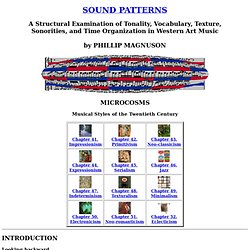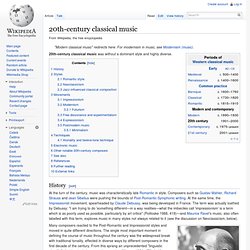

Online - Music Theory Online - Music of the 20th Century. Modern/20th Century Era - Composers. As of July 1, 2013 ThinkQuest has been discontinued.

We would like to thank everyone for being a part of the ThinkQuest global community: Students - For your limitless creativity and innovation, which inspires us all. Teachers - For your passion in guiding students on their quest. Partners - For your unwavering support and evangelism. Parents - For supporting the use of technology not only as an instrument of learning, but as a means of creating knowledge. We encourage everyone to continue to “Think, Create and Collaborate,” unleashing the power of technology to teach, share, and inspire. Best wishes, The Oracle Education Foundation.
The tapes from John Ronsheim's music classes at AntiochCollege. Click by date to hear the individual classes.

Note: the default files linked to "stream" and "download" for each class are high quality vbr mp3 files. If you have a slower-speed internet connection, or wish to download the uncompressed or ogg vorbis versions, click "more download options". September 21 [stream] [download] [more download options] Brief history of music from c. 1000-1859. 2h 44min 50s September 26 [stream] [download] [more download options] Wagner and reactions, Germanic and French: Deceptive cadences in Tristan und Isolde (1857-59) and Parsifal, then Mahler and Strauss, Satie and early Debussy. 1h 58min 47s September 28 [stream] [download] [more download options] Debussy: Prelude, Chansons de Bilitis, Nocturnes. 2h 17min 15s October 3 [stream] [download] [more download options] Puccini’s Tosca. 3h 4min 40s.
SOUND PATTERNS: Microcosms. A Structural Examination of Tonality, Vocabulary, Texture, Sonorities, and Time Organization in Western Art Music by PHILLIP MAGNUSON Musical Styles of the Twentieth Century Looking backward Before examining music of the 20th century, it is useful to take a look at the prevailing style in Western music that led us into it: the Common Practice Period (1600-1900).

The five basic elements that constitute the common practice: Tonality: The essential organization is around a single pitch, the tonic, which provides a home base to the ear. At a glance It is the basic premise of this unit that when a composer either generally modifies or completely changes more than one of these five elements, a new music (or UNcommon practice) is created. Each chapter will present a small table indicating how the style described in that chapter relates to the five elements of the Common Practice Period. The demise of the macrocosm The Common Practice Period offered a unified view of music (at least for Europe). 20th-century classical music. 20th-century classical music was without a dominant style and highly diverse.

History[edit] At the turn of the century, music was characteristically late Romantic in style. Composers such as Gustav Mahler, Richard Strauss and Jean Sibelius were pushing the bounds of Post-Romantic Symphonic writing. At the same time, the Impressionist movement, spearheaded by Claude Debussy, was being developed in France. The term was actually loathed by Debussy: "I am trying to do 'something different—in a way realities—what the imbeciles call 'impressionism' is a term which is as poorly used as possible, particularly by art critics" (Politoske 1988, 419)—and Maurice Ravel's music, also often labelled with this term, explores music in many styles not always related to it (see the discussion on Neoclassicism, below).
Arnold Schoenberg, Los Angeles, 1948 Many composers reacted to the Post-Romantic and Impressionist styles and moved in quite different directions. Igor Stravinsky.